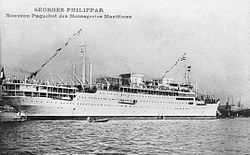Georges Philippar (ship)
|
The Georges Philippar in 1931
|
||||||||||||||||||||||
|
||||||||||||||||||||||
|
||||||||||||||||||||||
|
||||||||||||||||||||||
|
||||||||||||||||||||||
The Georges Philippar was a 1932 commissioned passenger ship of the French shipping company Messageries Maritimes , which was to be used for passenger traffic from France to the Far East . She and her two sister ships were the largest ships of the shipping company until then . On the return voyage from its maiden voyage , the luxury steamer was destroyed by a mysterious fire on May 16, 1932 off Cape Guardafui in the Gulf of Aden , the cause of which has not yet been clarified. 54 people died, all of them passengers . Among other things, sabotage , arson and a bomb attack were suspected. It is the shipping company's greatest disaster in peacetime.
The ship
The 17,359 GRT motor ship Georges Philippar was built from 1930 to 1932 in the Chantiers de l'Atlantique shipyard in Saint-Nazaire for the shipping company Messageries Maritimes founded in 1835. The shipping company was based in Paris , but the home port of their ships was Marseille on the Côte d'Azur . It was completed in January 1932.
She was the second in a series of three new sister ships . The other two were the Félix Roussel (1931), which was in service until 1960, and the Aramis (1932), which was seized by the Japanese during World War II and converted into a troop transport (both also 17,359 GRT). It was named after a former president of Messageries Maritime. The luxurious interior of the ship, unlike most other French passenger ships of the time, was not Art Deco , but very modern. Your two chimneys were not designed in the classic design, but had a rectangular cross-section. However, this did not catch on with later ships.
The maiden voyage
On Tuesday, February 23, 1932, the Georges Philippar cast off in Marseille under Captain Auguste Vicq on her maiden voyage to Yokohama . On the way back she stopped in Sàigòn , Shanghai and on May 10th in Colombo in Sri Lanka . There were 514 passengers and 253 crew members on board. Then the ship ran out of the Indian Ocean . The next destination should be Djibouti on the Gulf of Aden . On the evening of May 15th, Whitsun celebrations took place on board . On Monday, May 16, 1932, at around 2 a.m., the passenger saw Madame Valentin in luxury cabin 5 on D-deck smoke rising from an electrical commutator . They alerted the crew, whereupon an immediate attempt was made to isolate the fire . All the necessary switches were thrown to turn off the power lines in the area of the ship. Despite the efforts, however, the lines quickly caught fire before the affected part of the ship could be secured. At the time the fire was discovered, almost all passengers on board were asleep, so most of them wore pajamas and nightgowns when they came on deck. At that time, the ship was five miles from Cape Guardafui at the entrance to the Gulf of Aden.
Captain Vicq gave the order to turn the Georges Philippar in the direction of the wind and to stop the engines. The lifeboats were loaded and lowered into the water, whereby the boats in the middle area of the boat deck had to be constantly protected from the flames with fire extinguishers. The situation on the D-deck became worse and worse as the fire fighting equipment could not do anything against the flames. When the order was given to close the fireproof doors, numerous passengers were trapped in their cabins or in the corridors and could no longer escape. Many were suffocated in the thick smoke below deck.
The SOS signal could be sent five to six times before the radio system and the emergency generators on the upper deck caught fire and no further emergency calls could be made. The emergency calls were received by the British cargo ships Contractor of Harrison Line and Mahsud of Brocklebank Line and the 8,228 GRT Russian tanker Sovetskaïa Neft , who were on their way to the scene of the accident and arrived between 5 and 8 a.m. to collect the survivors. The Sovetskaïa Neft alone saved 420 people who were transferred to the French passenger ship André Lebon and brought to Djibouti. Other survivors were put ashore in Aden.
Around 8 a.m., Captain Vicq inspected all the first and second class cabins that were still accessible and did not leave the burning Georges Philippar until he was satisfied that no one was on board. He was the last to leave the ship. Despite severe burns to his face and legs, he kept the boat he was in looking for survivors. During the day, the NUC burned luxury cruise ship drifting with impact side approximately 45 miles north in the flow. On the night of May 19-20, the Georges Philippar finally sank off the Arabian coast. 54 people were killed in the fire, all of them passengers, including the renowned French journalist and author Albert Londres .
Captain Vicq later testified that the fire alarm went on for no reason about a week before the fire. This happened again about half an hour before the fire on May 16. In both cases it was completely unclear how and by whom the alarm had been triggered. In addition, it has never been possible to determine clearly what had caused the fire on board the Georges Philippar . A crime is not excluded; there has been speculation , among other things, of arson and even a bomb attack by terrorists or rebels.
Others
The surviving couple Alfred and Suzanne Lang-Willar were supposed to be flown from Brindisi to Marseille by plane on May 25 , but the plane crashed on Monti Ernici near the city of Veroli . The couple and both pilots, Marcel Goulette and Lucien Moreau, died.
